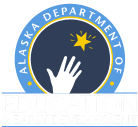- Cama-i, quyana tailuci!
- (Central Yup’ik)
- "Greetings, thank you for coming!"
Evidence-Based Resources
The Alaska Department of Education and Early Development supports school districts in adopting proven strategies that are backed by evidence and shown to inprove student outcomes. An evidence-based activity, strategy, or intervention is one that meets at least one of the following criteria:
- Shows a statistically significant positive effect on student or related outcomes, based on:
- Strong evidence from at least one well-designed and well-implemented experimental study; OR
- Moderate evidence from at least one well-designed and well-implemented quasi-experimental study; OR
- Promising evidence from at least one well-designed and well-implemented correlational study with controls for selection bias; OR
- Demonstrates a rationale based on high-quality research or positive evaluation (e.g., the National Reading Panel) and includes ongoing evaluation of its impact.
National Center on Intensive Intervention (NCII) provides excellent resources to help districts make informed decisions when selecting intervention materials or sharing information with parents.
Academic Intervention Tools Chart – identifies whether materials are research-based, reliable, and valid, and outlines the components they cover.
Academic Progress Monitoring Tools Chart – provides information on effect size and other key measures.
(Section 8101(21)(A) of the Every Student Succeeds Act – ESSA)

DEED Approved Courses and Exams
Alaska Native Language Literacy
Family & Community Support Resources
FAQs
Review Processes for Courses
